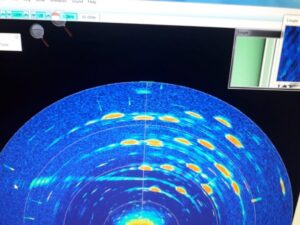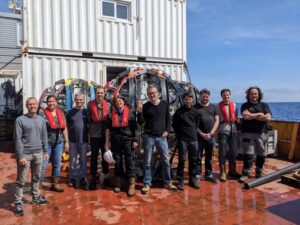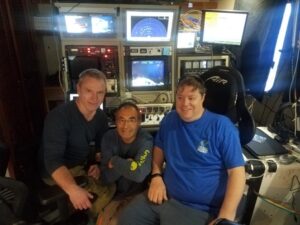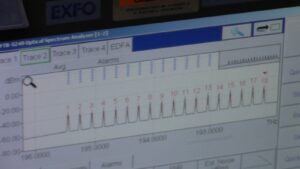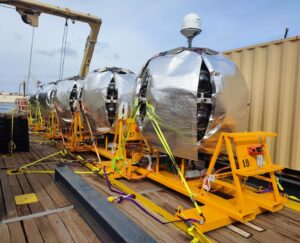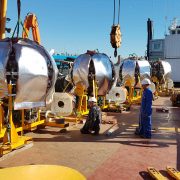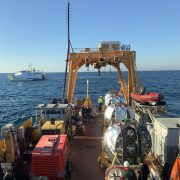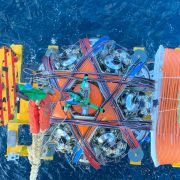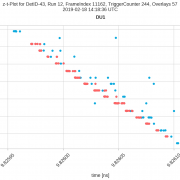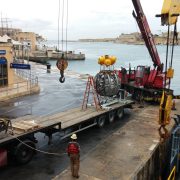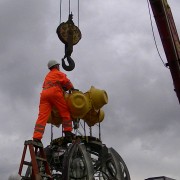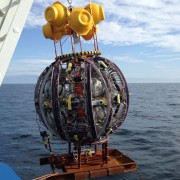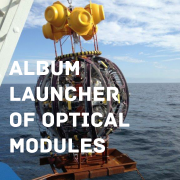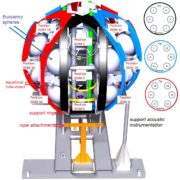
20 November 2020 – The KM3NeT Collaboration has published a new paper, in which we describe in detail the innovative deployment method for KM3NeT detection units.
No standard moorings
A custom design was necessary, because the KM3NeT mooring – the detection unit -is different from moorings typically used for oceanography.
For instance, in KM3NeT moorings the instrumentation is contained in transparent and thus unprotected glass spheres. That makes them vulnerable during deployment. Moreover, we use a long, thin and soft tube with optical fibres and thin copper wires for data transmission and electrical power for the instruments. That makes the units even more vulnerable.
On top of that, because we use thin Dyneema ropes as strength members in stead of a standard steel cable the mooring is not strong enough to carry the weight of the anchor during deployment.
All this makes it more difficult to deploy the unit without breaking it and we needed a customised deployment method.
Different from other telescopes
Compared to other neutrino telescopes such as ANTARES in the Mediterranean Sea and GVD in Lake Baikal, we designed the KM3NeT detection unit even more slender to minimise the amount of material used for support of the sensor modules. An other – economical – difference is that we have to deploy hundreds of units more for KM3NeT in a period of a few years while keeping the costs for sea operations at a minimum. These are even more reasons for innovation of the deployment method.
The LOM
We developed a custom-made, fast deployment method. Despite the length of the detection unit of several hundreds of metres, we managed to compact it into a small, re-usable spherical launching vehicle instead of deploying it weight down from a surface vessel – the standard method in oceanography. We dubbed the vehicle LOM for Launcher of Optical Modules.
The tric
Once the LOM has reached the seafloor, the innovative tric begins. The buoyant LOM rolls upwards along the Dyneema ropes. While doing so, it spits out the glass spheres with instrumentation attached to the ropes. As a result, while floating to the surface, the LOM leaves the detection unit behind at the seabed, unfurled to its full vertical length. Ready for data taking during many years to come.
Cost effective
The LOM has two economical advantages. First, it does not take a lot in space. Therefore, during a sea operation many LOMs can be stored on deck of a ship. Secondly, we can lower the LOM to the seabed at high speed. As a result, we need less expensive ship time for the installation of the KM3NeT telescope.
Cooperation
As far as we know, the method of compact deployment of moorings with a LOM is unique. The method is the result of close cooperation between engineers and scientists in the KM3NeT Collaboration from both oceanographic and astrophysics institutes. We hope it will inspire oceanographic scientists for the design and deployment of their future moorings.
Details
In the paper, we describe the details of the design of the LOM, the loading with a detection unit, and its underwater self-unrolling. You find the reference below.
LOM in pictures
Pictures below reflect the process from idea to realisation. First an impression of the initial ideas for deployment by @Marijn van der Meer/Quest. Followed by the technical design of the KM3NeT detection units that must be installed and the design of the LOM launcher vehicle. Finally, photos of the first prototype of the LOM and the final version that is now regularly used for the installation of the detection units of the ARCA and ORCA detectors of the KM3NeT telescope.
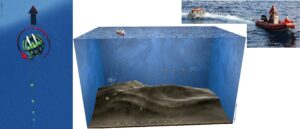
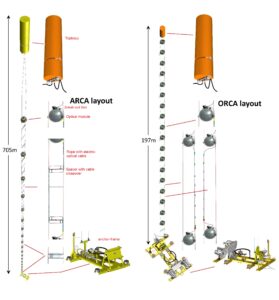

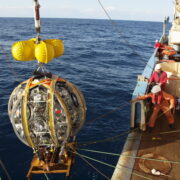
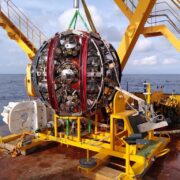
Reference
Deep-sea deployment of the KM3NeT neutrino telescope detection units by self-unrolling
The KM3NeT Collaboration: S. Aiello et al
2020 JINST 15 P11027
https://doi.org/10.1088/1748-0221/15/11/P11027

